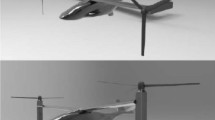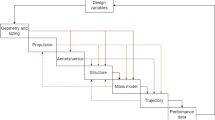Abstract
A detailed technical design and performance comparison of current unmanned Vertical Take-Off and Landing (VTOL) vehicles is presented as a function of vehicle maximum speed, payload, range, endurance, and propulsion configurations. Mission applications and VTOL market characteristics are used to define design specifications for a new prototype unmanned VTOL vehicle suitable for a wide range of (mostly) civilian applications. The proposed VTOL vehicle's design phase is presented, including: performance capabilities calculation, fuselage strength evaluation and weight optimization via crash/drop tests. Drop tests performed have followed standard regulations used for airworthiness certification of such vehicles. The proposed VTOL vehicle is currently under prototype development.
Similar content being viewed by others
References
Adams, V., Askenazi, A.: Building Better Products with Finite Element Analysis. Onword, USA (1999)
Civil Aviation Safety Authority Australia: Design standards: Unmanned Aerial Vehicles-Rotorcraft (2000)
Coleman, P.C.: A Survey of Theoretical and Experimental Coaxial Rotor Aerodynamic Research, NASA Technical Paper 3675 (1997)
Davis, J.R.: Aluminum and Aluminum Alloys. ASM International, USA (1993)
Doitsidis, L., Valavanis, K.P., Tsourveloudis, N., Kontitsis, M.: A framework for fuzzy logic based UAV navigation and control. In: Proceedings of the IEEE International Conference on Robotics and Automation, pp. 4041–4046. New Orleans, USA (2004)
Federal Aviation Administration (FAA): Unmanned Aerial Vehicle Design Criteria, Advisory Circular (DRAFT)
Seddon, J.: Basic Helicopter Aerodynamics. BSP Professional Books, Oxford (1990)
Kontitsis, M., Tsourveloudis, N., Valavanis, V.: A UAV vision system for airborne surveillance. In: Proceedings of the 2004 IEEE International Conference on Robotics and Automation (ICRA), vol. 1, pp 78–83 (2004)
McCormick, B.W.: Aerodynamics Aeronautics And Flight Mechanics. Wiley and Sons, New York (1995)
Murthy Sreekanta, T., Kvaternik, R.G.: Experiences at Langley Research Center in the Application of Optimization Techniques to Helicopter Airframes for Vibration Reduction, NASA Technical Memorandum 104193 (1991)
NATO Committee for European Airspace Coordination: Guidance For Unmanned Aerial Vehicles (UAV) Operations, Design Specification, Maintenance and Training of Human Resources, Annex to NATO Document AC/92-D/967
Prouty, R.W.: Helicopter Performance Stability, and Control. Krieger, Florida (1990)
Spanoudakis, P., Doitsidis, L., Tsourveloudis, N.C., Valavanis, K.P.: Vertical take-off and landing vehicle market overview. Unmanned Systems Magazine 21(5):14–18 (2003)
Spanoudakis, P.: Design of a new vertical take-off and landing unmanned aerial vehicle, Master Thesis, Department of Production Engineering and Management, Technical University of Crete (2003)
Stepniewski, W.Z., Keys, C.N.: Rotary-Wing Aerodynamics. Dover, New York (1984)
U.S. Department of Defence: Metallic Materials and Elements for Aerospace Vehicle Structures, Military Standard MIL-HDBK-5J (2003)
U.S. Department of Transportation-Federal Aviation Administration: Certification of Normal Category Rotorcraft, Advisory Circular 27-1B (1999)
Unmanned Vehicles Handbook 2002, The Shepard Press Publications (2002)
Van Blyenburgh, P.: UAVs: an overview. Air Space Eur. 1(5/6), 43–47 (1999)
Author information
Authors and Affiliations
Corresponding author
Rights and permissions
About this article
Cite this article
Spanoudakis, P.S., Tsourveloudis, N.C. & Valavanis, K.P. Design Considerations of a Prototype VTOL Robotic Vehicle through Market Survey Data Collection. J Intell Robot Syst 46, 339–364 (2006). https://doi.org/10.1007/s10846-006-9057-1
Received:
Accepted:
Published:
Issue Date:
DOI: https://doi.org/10.1007/s10846-006-9057-1




